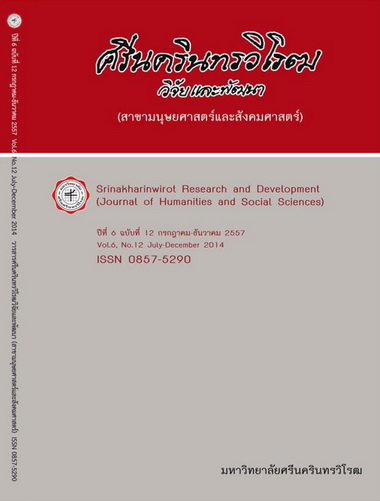การพัฒนารูปแบบการเรียนการสอนเขียนกาพย์ยานี 11 โดยใช้ทฤษฎีพหุปัญญาเป็นฐาน เพื่อพัฒนาผลสัมฤทธิ์ทางการเรียนวิชาภาษาไทยของนักเรียนชั้นประถมศึกษาปีที่ 5 โรงเรียนเทศบาลเขาพิทักษ์
Keywords:
A Kabyanee 11 Instructional Model, Multiple Intelligences, Thai Language AchievementAbstract
บทคัดย่อ
การวิจัยครั้งนี้มีวัตถุประสงค์เพื่อพัฒนารูปแบบการเรียนการสอนเขียนกาพย์ยานี 11 โดยใช้ทฤษฎี พหุปัญญาเป็นฐานและศึกษาผลการใช้รูปแบบดังกล่าวพัฒนาผลสัมฤทธิ์ทางการเรียนวิชาภาษาไทยนักเรียน ชั้นประถมศึกษาปีที่ 5 โรงเรียนเทศบาลเขาพิทักษ์กลุ่มตัวอย่างเป็นนักเรียนชั้นประถมศึกษาปีที่ 5 โรงเรียนเทศบาลเขาพิทักษ์ ซึ่งสุ่มมาด้วยวิธีการเลือกแบบเจาะจง การดำเนินการวิจัยแบ่งออกเป็น 3 ขั้นตอน คือ 1) การพัฒนารูปแบบการเรียนการสอนเขียนกาพย์ยานี 11 โดยการสังเคราะห์สาระสำคัญของทฤษฎีพหุปัญญาและเชื่อมโยงสาระสำคัญที่สังเคราะห์ได้กับองค์ประกอบของรูปแบบการเรียนการสอนเขียนกาพย์ยานี 11 2) การทดลองใช้รูปแบบการเรียนการสอนเขียนกาพย์ยานี 11 โดยเปรียบเทียบผลสัมฤทธิ์ทางการเรียนของนักเรียนก่อนเรียนและหลังเรียน กลุ่มทดลองที่เรียนด้วยรูปแบบการเรียนการสอนที่ผู้วิจัยพัฒนาขึ้น เครื่องมือที่ใช้ในการวิจัยคือ แผนการจัดการเรียนรู้ และแบบวัดผลสัมฤทธิ์ทางการเรียนการสอนเขียนกาพย์ยานี 11 ประกอบด้วย แบบทดสอบความรู้ แบบประเมินคุณธรรมและเจตคติ และแบบทดสอบทักษะการเขียนกาพย์ยานี 11 และ 3) การประเมินผลรูปแบบการเรียนการสอนเขียนกาพย์ยานี 11 วิเคราะห์ข้อมูลโดยหาค่าเฉลี่ย ส่วนเบี่ยงเบนมาตรฐาน และเปรียบเทียบความแตกต่างระหว่างค่าเฉลี่ยโดยการหาค่าที (Dependent t - test) และทดสอบความมีนัยสำคัญทางสถิติที่ระดับ 0.05
ผลการวิจัยแสดงให้เห็นว่า
1. การพัฒนารูปแบบการเรียนการสอนเขียนกาพย์ยานี 11 โดยใช้ทฤษฎีพหุปัญญาเป็นฐานเพื่อพัฒนาผลสัมฤทธิ์ทางการเรียนวิชาภาษาไทยของนักเรียนระดับประถมศึกษาปีที่ 5 มีองค์ประกอบสำคัญ 4 ประการ ได้แก่ หลักการของรูปแบบการเรียนการสอน วัตถุประสงค์ของรูปแบบการเรียนการสอน กระบวนการจัดกิจกรรมการเรียนการสอน และการวัดและประเมินผล วิเคราะห์ความตรงเชิงเนื้อหาด้วยการหาค่าดัชนีความสอดคล้อง (Item Objective Congruence) ได้ค่าเท่ากับ 0.89 นับว่าเป็นรูปแบบที่มีคุณภาพและสามารถนำไปใช้ได้
2. ผลการทดลองใช้รูปแบบ แสดงว่า นักเรียนชั้นประถมศึกษาปีที่ 5 ที่เข้าร่วมกิจกรรมตามรูปแบบการเรียนการสอนที่พัฒนาขึ้นมีผลสัมฤทธิ์ทางการเรียนวิชาภาษาไทยหลังการเรียนสูงกว่าก่อนการเรียนอย่างมีนัยสำคัญทางสถิติที่ระดับ 0.05 คือ ด้านความรู้ คุณธรรมและเจตคติและทักษะการเขียนกาพย์ยานี 11
Abstract
The purposes of this research were to develop a Thai language instructional model based on the Theory of Multiple Intelligences to improve Thai language learning achievement of the Prathomsuksa five students and to study the effectiveness of this model. The samples were Prathomsuksa five students of TesabanKaopituk School. The research procedures were divided into three phases. The first phase was the development of an instructional model by synthesizing the notions of the Multiple Intelligences Theory and merging them with the components of a Thai language instructional model. The second phase was the experiment of a Thai language instructional model by comparing the pre-post effectiveness of the experimental groups taught by this model. The research instruments were the lesson plans and the Thai language learning achievement tests: knowledge, moral and attitudes and KABYANEE 11 skills. And the third phase was the evaluation of a Thai language instructional model. Data were analyzed by means, standard deviation, dependent and independent t-test, at 0.05 levels of significance.
The findings were as follows:
1. The instructional model consisted of four parts; they were the principles, the objectives, the processes, and the measurement and evaluation with item objective congruence (IOC) at 0.89.
2. The effectiveness of this model was as follows: The Prathomsuksa five students who participated in the instructional model had higher post-test scores of physical education learning achievement significantly different at 0.05 level than their pre-test scores. They were knowledge, moral and attitudes and KABYANEE 11 skills.
Downloads
Downloads
Published
How to Cite
Issue
Section
License
Srinakharinwirot Research and Development Journal of Humanities and Social Sciences is licensed Under a Creative Commons Attribution-NonCommercial-NoDerivs 4.0 International (CC-BY-NC-ND 4.0) License, Unless Otherwise Stated. Please Read Journal Policies Page for More Information on Open Access, Copyright and Permissions.



